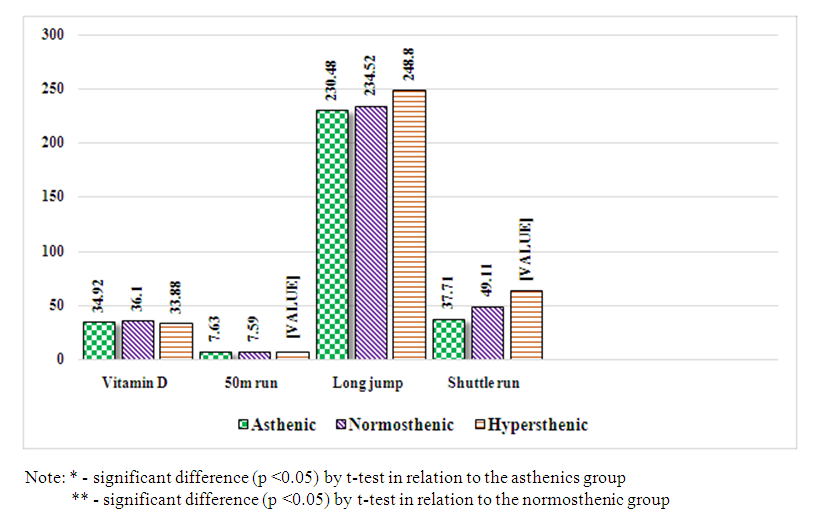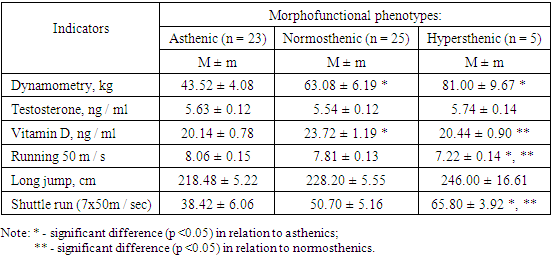-
Paper Information
- Next Paper
- Paper Submission
-
Journal Information
- About This Journal
- Editorial Board
- Current Issue
- Archive
- Author Guidelines
- Contact Us
American Journal of Medicine and Medical Sciences
p-ISSN: 2165-901X e-ISSN: 2165-9036
2022; 12(1): 53-56
doi:10.5923/j.ajmms.20221201.10
Received: Dec. 24, 2021; Accepted: Jan. 24, 2022; Published: Jan. 27, 2022

The Relationship of Physical Fitness of FC Bunyodkor Football Players with Indicators of Level 25 (OH) D and Testosterone
L. A. Skvortsova
Basic Doctoral Student, Republican Scientific and Practical Center of Sports Medicine, Uzbekistan, Tashkent
Correspondence to: L. A. Skvortsova, Basic Doctoral Student, Republican Scientific and Practical Center of Sports Medicine, Uzbekistan, Tashkent.
| Email: |  |
Copyright © 2022 The Author(s). Published by Scientific & Academic Publishing.
This work is licensed under the Creative Commons Attribution International License (CC BY).
http://creativecommons.org/licenses/by/4.0/

The article presents the data of own research of FC «Bunyodkor» football players and the results of indicators of vitamin D, testosterone levels and indicators of control and pedagogical testing in 4 seasons of one annual cycle.
Keywords: Morphofunctional phenotype, Football players, Vitamin D, Testosterone, Control and pedagogical testing
Cite this paper: L. A. Skvortsova, The Relationship of Physical Fitness of FC Bunyodkor Football Players with Indicators of Level 25 (OH) D and Testosterone, American Journal of Medicine and Medical Sciences, Vol. 12 No. 1, 2022, pp. 53-56. doi: 10.5923/j.ajmms.20221201.10.
1. Introduction
- The results of many conducted studies prove the positive effect of VD on endurance, fitness, physical fitness, performance, strength of athletes, on the state of musculoskeletal tissue and water-salt metabolism. [5,7] Manifestation of human physical qualities depends in different proportions on both genetic and environmental factors. Special training of young athletes is of fundamental importance in the realization of abilities according to morphological and functional characteristics in a certain kind of sport [1,6].According to the author's definition, "... the main structural component of the constitution, its kind of anatomical passport is the somatic type (somatotype) or morpho-phenotype" [3]. The somatotype is the most ontogenetically stable macromorphological subsystem of the general constitution available to objective anthropometric measurements, therefore it can be used as the basis for constitutional diagnostics. A quantitative assessment of the constitutional characteristics of a person makes it possible to give a comprehensive description of each individual [4].As shown by the results of studies in the blood of men, seasonal fluctuations in the level of VD are noted: in the summer-autumn time - high, in the winter-spring time - low, there are similar fluctuations in the concentration of the hormone testosterone by the seasons of the year [2].
2. Research Methods
- Morphofunctional status of 53 young sportsmen-football players of the football club "Bunyodkor" at the age of 15.89 ± 0.23 years. In the studied sample, athletes were examined according to a comprehensive program (clinical and laboratory, somatometric (anthropometric) and physiometric studies, assessment of physical development, indicators of sports and competitive success based on control and pedagogical tests (running at a distance of 50 meters, shuttle running 7x50, long jumps The choice of football players of FC Bunyodkor as the main group is due to a number of factors that are of fundamental importance for the implementation of the tasks set - this is homogeneity in place of residence, age, gender, ethnicity, one kind of sport and a stage of sports improvement that do not travel to other countries to compete during the study period.To assess the morpho-phenotype of the athletes under study, we used anthropometric, self-metric and physiometric indicators (height, weight, chest circumference, caliperometry, VC, hand dynamometry) with subsequent calculation of indices and centile intervals. Currently, there are many schemes for determining the somatic type of a person. So, to calculate the morpho-phenotype, among the many schemes of normal constitutions, three constitutional body types are usually distinguished. We used the method for determining the types of human constitution according to WH Sheldon, 1929 - hypersthenic, normosthenic and asthenic types.
3. Research Results and Discussion
- In order to study the relationship between sports readiness, muscle strength and actual concentrations of serum 25 (OH) VD and total testosterone in football players of FC "Bunyodkor", dynamometry and control-pedagogical tests (running at a distance of 50 meters, standing long jump and shuttle run 7x50). The study of indicators in the summer season of the year between different body types is presented in Figure 1.
 | Figure 1. Physical endurance indicators in football players with different morphological and functional phenotypes in the summer season |
|
|
 | Figure 2. Physical endurance indicators of sportsmen-football players with different morphological and functional phenotypes in the spring season of the year |
4. Conclusions
- The results of the research carried out confirm the need to control the parameters of the morphological and functional data of young sportsmen-football players of FC "Bunyodkor". The results of studying the somatotype of sportsmen-football players of FC "Bunyodkor" with the use of objective anthropometric measurements made it possible to obtain a quantitative assessment of the constitutional characteristics and complex characteristics of each sportsman. Assessment of the morphological and functional development of 53 sportsmen-football players of FC "Bunyodkor" at the age of 15.89 ± 0.23 years using a one-dimensional centile scale and Sheldon somatotype allowed to distribute (43.4%) athletes into the asthenic group, (47.7%) into the group of normosthenic and (9.4%) in the group of hypersthenic constitutional types. It was found that in the winter period of the year in athletes with hypersthenic type there was a statistically significant difference in% BMI (11.22 ± 0.92) compared with asthenic type (9.49 ± 0.33), p <0.05.In the group of athletes with asthenic type, BMI is statistically significantly lower by 5.7% compared to the normosthenic type and by 15.3% lower compared to the hypersthenic body type.The results of studying dynamometry in Bunyodkor football players with different body types in different seasons of the year showed that the maximum dynamometry indicators for all body types occur in the spring season, and the minimum indicator in the summer and autumn.The athletes of FC Bunyodkor with asthenic morpho-phenotype in the summer, autumn and winter seasons of the year have a deficiency (17.37-24.27 ng / ml), in the spring season the adequate content of 25 (OH) D at 34.92 ng / ml ... In football players with a normosthenic morphofunctional phenotype in the summer, autumn and winter seasons of the year, a deficiency was established at the level of 18.25-23.72 ng / ml, and in the spring an adequate content of 25 (OH) D (36.10 ± 0.88 ng / ml) ... In the summer, autumn and winter seasons, the asthenic and normosthenic morphofunctional phenotypes are characterized by stable values of the total testosterone index. In hypersthenics in winter, the OT content at the level of 5.74 ± 0.14 ng / ml is significantly higher than the indicators in summer (4.62 ± 0.19 ng / ml) and autumn (4.48 ± 0.27 ng / ml). The concentration of the hormone in the spring season, regardless of the morphofunctional phenotype, varies in the range from 6.46 ± 0.18 to 6.86 ± 0.13 ng / ml and is statistically significantly higher than in the rest of the seasons of the year ( p <0.05).Linear regression analysis showed significant associations between OT and 25 (OH) D levels (p <0.05). Concentrations OT (4.62 ± 0.19 ng / ml) and VD (from 17.37 to 24.27 ng / ml) were subject to seasonal fluctuations with the lowest values in July, respectively, and a peak in March OT (6.86 ± 0.13 ng / ml) and VD (36.10 ± 0.88 ng / ml), respectively (p <0.05).
 Abstract
Abstract Reference
Reference Full-Text PDF
Full-Text PDF Full-text HTML
Full-text HTML
